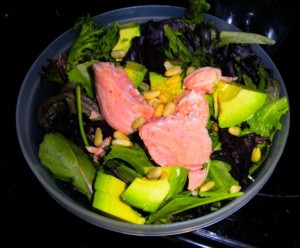Navigating the risks of mercury.
Every week or so, I see an article on the importance of fish for good health and how we all should eat more. Then a line or two on how people should avoid mercury because it can be so dangerous, etc. I suspect the take-home message most people are receiving is “you should eat fish, but it’s risky.”
So let’s break it down and make it easy. The American Heart Association recommends 2 or more servings of fish a week, preferably fatty fish, like salmon, mackerel, herring, lake trout, sardines, etc. Aside from heart disease, there are so many reasons why fish can be beneficial–omega 3 fatty acids are anti-inflammatory and may help with conditions from high triglycerides, rheumatoid arthritis, macular eye degeneration, high blood pressure, depression and the list just goes on.
Studies show that while mercury, PCBs, etc. are associated with health risks, the risks of NOT eating fish are higher. In other words, the potential benefits outweigh the risk.
Fortunately, a lot of the highest omega 3 fish are low in mercury, too.
- Salmon
- Trout
- Sardines
- Anchovies
- Oysters
- Flounder
Steer clear, or limit the big fish…they’ve accumulated a lot of mercury as they’ve eaten up the little fishies.
- Shark
- King Mackerel
- Tilefish
- Swordfish
For pregnant, breastfeeding moms and little ones, those listed above should all be off the table.
Tuna is also moderately high in mercury, especially albacore tuna. We’re best to limit tuna to 6 oz a week, or if you’re eating canned, choosing a lower mercury variety like skipjack tuna is wise. For all you sushi aficionados, the much of the tuna used tends to come from larger fish, which are higher in mercury. Or just trade in your tuna for canned salmon, which is usually wild-caught, higher in omega 3s and lower in mercury.
My favorite new resource puts the info on omegas and mercury together nicely, so you can see how your favorite fish stacks up. Or, if you want to calculate your mercury level for a week and see how you’re doing, check out a nifty calculator from GotMercury.org You can crunch the numbers based on what you’re eating and your size, and that can give you a good sense of where you stand in relation to the recommended limit. Or you can check out the FDA listing of mercury in fish.
What about sustainability and the environment, the politics and health of wild/vs. farmed, etc.? That’s a whole different discussion! The short answer is to check out a seafood guide, such as the one from the Monterey Bay Aquarium.
But what about the flaxseed you’re adding to your yogurt faithfully every day? That has omega 3s, too, as does walnuts, canola oil, soy, chia seed and more. This form of omega 3s, called ALA, does have health benefits. However, it does not seem to have all of the same benefits as the omegas in fish. But what about if you’re vegan or allergic to fish? There are DHA supplements available that are derived from algae.
Speaking of supplements, generally, a low dose (around 1 gram) is generally considered safe, but definitely don’t go for high dose supplements (over 3 grams) without having a chat with your doctor.
Harris Whole Health offers individual sessions, family sessions and group classes to help people eat healthier and feel better! Whether you are dealing with Celiac Disease, food allergies, picky eaters, children on the Autistic spectrum, chronic illness, or if you just want to feel and look better, Cheryl can help you achieve your goals. For an appointment with Cheryl Harris, Registered Dietitian and Nutritionist, please click here or call 571-271-8742.
